Hiking and Exploring the Cinque Terre
As of Saturday, April 20, 2019: Current: Vernazza to Corniglia Blue Trail is currently closed due to poor weather last week for an unknown amount of time.
It has recently been published that proper shoes are required for hiking the trails. The trails are mostly dirt, stone, and steps. Tennis shoes, running shoes, hiking shoes/boots are necessary. You can be fined up to $2,800 for inappropriate footwear!
Also, highly recommended you bring water (especially in warmer months). There are no water stops between the villages.
(note, this post is often being updated with the latest trail hiking news. I live here and hike the trails often. Feel free to send me any questions!)
(scroll all the way down for What to See/Do in each village)
One of my favorite escapes!
The Cinque Terre (five lands) are five very beautiful, vividly colorful fishing villages located on cliffs overlooking the sea. A Unesco World Heritage Site since 1997, and thus frequented by tourists, the Cinque Terre isn't the undiscovered virgin land it once was. That doesn't mean it isn't worth every square inch of its beauty! In this post I'm going to share both the hiking/walking adventures available as well as what to see in each of the five villages.
The Hiking/Walking trails offer unbelievable scenery which draw many tourist to the Cinque Terre. A few of the most favored trails, the easier, shorter ones between the villages, are closed. But not all of them! And there is plenty of hiking surrounding the CT as well.
There are two trails between each of the villages - the lower one (Blue Trail). This is the most popular and well traveled trail. Details for each section are below!!
And the upper one (Red Trail or High Trail). I'm going to warn you now, the upper trail is long and difficult...
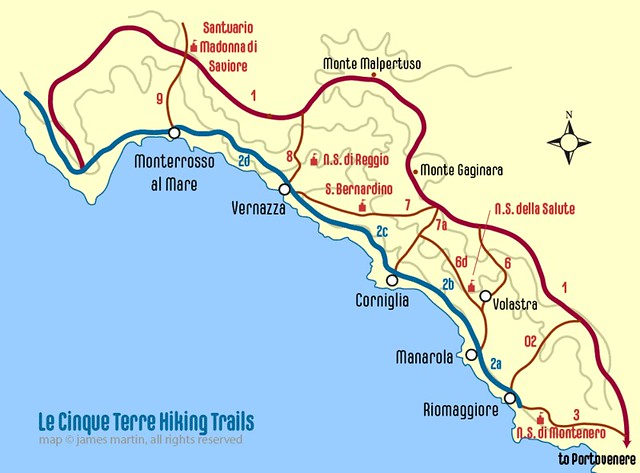
Here's a brief to what trails are open/closed:
Monterosso to Vernazza is open!
Both trails. The Blue Trail is 3.8km (2.4 miles, elevation gain almost 800 feet or 250 meters - profile below), easy to moderate. This route can be quite tiresome if you are not fit but it offers spectacular views!! The trail is marked well in white and red. It leaves from the eastern part of the old town of Monterosso. Take the small pedestrian road leading to the Hotel Porto Roca. The path begins with a long staircase (this is as difficult as it gets). The footpath continues flat, but in some parts it is very narrow and a little rolling. The trail passes on an antique stone-bridge, which is really worth a picture! When the trail begins to go down, the view of Vernazza is really breathless. From the bottom of the stairs in Monterosso to the bottom of the stairs in Vernazza, it is exactly 2.4 miles.
The upper route is 7.3km (4.5 miles), moderate to difficult - recommend for advanced hikers.

Elevation Profile for Blue Trail hike from Monterosso to Vernazza
Vernazza to Corniglia is open! - currently CLOSED
Both trails. The Blue Trail is 3.2km (2 miles), easy. Most popular trail. From both direction you'll climb climb climb then descend descend descend.
The upper route is 6.5km (4 miles, 900 feet elevation), difficult.
Corniglia to Manarola: The Blue Trail is closed. The long route is open!
The upper route is 3.1km (2 miles), easy (but there's a section of difficult stairs).
It goes through Volastra. From Volastra to Manarola there are about 1,200 steps to tackle.
Manarola to Riomaggiore (Lover's Lane) is closed. Both routes are closed due to landslides. There is one small section of Lover's Lane that you can capture some beautiful photos and enjoy a drink at a bar, but otherwise, no hiking.
If you only have one day: I recommend starting in Monterosso, explore for an hour, hike to Vernazza, explore and enjoy lunch, and hike to Corniglia. Once in Corniglia, grab a gelato or lemon slushy.
Next, make sure you take the paths down down down to the sea. It's not an easy climb back up (lots of stairs), but you can take a dip in the sea and it's just fabulous down there! Take the train to Manarola, explore, and then the train to Riomaggiore. The villages are small enough that you can explore for an hour if you only have one day in CT. If you have more time, spend more time and go through each site! Alternatively, start in Rio and head towards Monterosso.
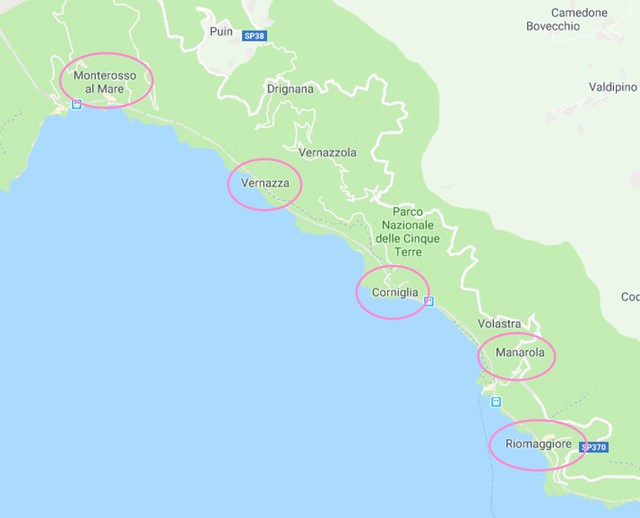
For all of those trails, you need the Cinque Terre Card. They will check your card or charge you on the trail. So either buy the card in advance or carry cash. It's cheaper to buy the card before you arrive (7.50euro as opposed to 9euro or whatever the guy wants you to pay onsite; no CC accepted!).
You can get the Trekking card for hiking only or the Treno card which includes all the trekking and unlimited train services. I recommend this one!
Those are the most popular and sought after trails. Now let's explore some of the others!!
Back up to Monterosso. There is some beautiful hiking continuing north!
Monterosso to Levanto is open. The trail is 6.8km (4.2 miles), moderate to difficult.
You don't have to do the whole trail. You can hike to Punta Mesco for some photos and head back to Monterosso. This portion will take you about 90mins roundtrip.
If you go all the way to Levanto, there is more!
Levanto to Bonassola to Framura is also open. This route is 5.7km (3.5 miles) and very easy.
This is an interesting trail as the old railway tunnel was restored and transformed into a cycle track. The most popular part of this stretch is between Levanto and Bonassola. The road often comes out of the tunnel into the open and from these points you can go down to the small enclosed beaches that are located along the route. You can even rent a bike.
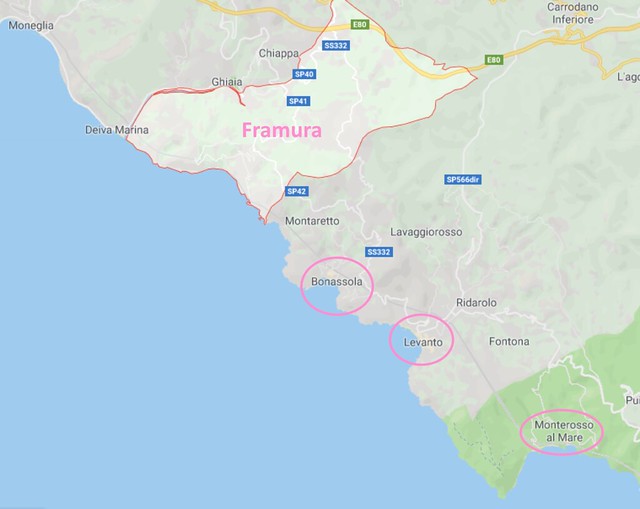
If you love hiking, there is even more to explore:
The Ring of Riomaggiore open. 3.5km (2.1 miles), easy route.
The Sanctuary of Montenero, near Riomaggiore, is well-known thanks to the beautiful panoramic view that it offers. The best thing to do is to take this trail in a clockwise direction, because from the Shrine to the village you will find a great number of steps.
The Ring of Vernazza open. 6.8km (4.2 miles), moderate difficulty.
This trail passes near two shrines. I recommend taking the trail in a clockwise direction.
If you follow the trail counterclockwise, you have to purchase the Cinque Terre Card, because the first fifty meters of the trail passes along the Blue Trail. Also, the ascent to San Bernardino is very tiring, so it makes no sense to walk the trail in this direction.
The Island of Palmaria open. 6km (3.7 miles), moderate difficulty.
You don’t have go the whole way around the island, it just depends on how much you want to do, and the time you have available. You can do a short walk or the long one, visiting all the hamlets on the island.
Riomaggiore to Portovenere open. 12.7km (7.9 miles), moderate difficulty.
The longest of the famous trails of the Cinque Terre. Plan for an entire day of hiking, 6-8 hours. And bring lunch!!
If you're the most serious of hikers, this one is for you! It's the entire High Trail (info to come).
See a list of all 48 trails here.
Whether you're hiking to explore the villages or taking the train between the five, here is what to see and do in each village:
Monterosso is the biggest (about 1,500 inhabitants) and the oldest of the Cinque Terre’s villages. It is divided into 2 parts: the old and the new village. The biggest beach of the entire coast is situated here; because of this, it is the most visited town. It has a very resort kind of feel; plenty of restaurants, the only real beach, and it has the most activity of the CT.
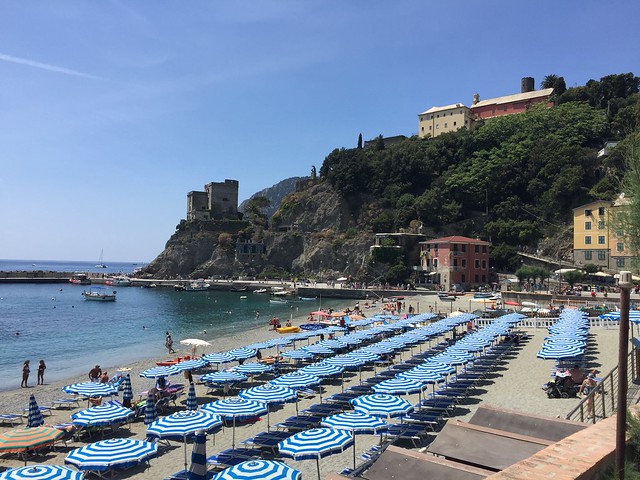
What to see in Monterosso:
- Church of St. John the Baptist: The Church was built in the XIII-XIV centuries, and it is situated in the old part of the town, not far from the sea. Architectural style: gothic.
- Chapel of Mortis et Orationis: Near the Church of St. John the Baptist, there is the Chapel of Mortis et Orationis. Its name stands for "Death and Prayer". Architectural style: baroque.
- Capuchin Monastery: The Church of San Francesco together with the Cappuccini Monastery was built during 1619-1622. They are situated on the top of the hill that separates the old part of the town from the new one (San Cristoforo Hill).
- The Aurora Tower: In the past, Monterosso was guarded very well: there were thirteen towers, but only three are left as of today, and one of them is the Aurora Tower; next to it, on San Cristoforo Hill, there was a castle, and there was the Monastery of San Antonio al Mesco as well. Unfortunately, nothing is left now. The tower was built in the XVI century and it is currently used as a private house.
- The Giant or Neptune: On the outskirts of the new town in Monterosso, on Fegina beach, there is a gigantic statue: famous sculptor Arrigo Minerbi and engineer Levacher built it in 1910. The statue depicts Neptune carrying a gigantic seashell. The statue weighs about 1,700 tons, and is 14 meters high. The sculpture was heavily damaged during World War II and by a severe storm in 1966.
- Soviore Sanctuary: It is the most ancient Temple in Liguria, which was first documented in 1225 and, probably, it dates to the time of Rotary invasion.
- The Temple of the Madonna of Soviore, the Mistress of the sea and patroness of seafarers, consists of a church, a shelter and a bell tower. The structures were extended in the XVII century, but restauration is still in progress.
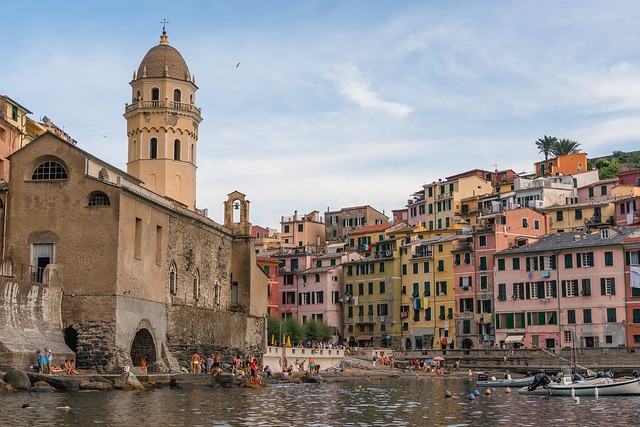
What to see in Vernazza:
- Church of St. Margaret of Antioch: The church was built in the XI-XII centuries; the exact date is unknown. Architectural style: Roman (in 1750 it was changed to baroque, and in 1970, after one major renovation, the original style was restored).
- Church of San Francesco: Built in the XVII century, it includes a quadrangular tower of the XVI century and remains one of the most ancient walls.
- Palace with porticoes: Opposite the Church of St. Margaret, there is an old building with narrow galleries. It is a traditional meeting place for the residents of Cinque Terre.
- Belforte Tower and A. Doria Castle: This castle was built in the XI century for protection of the village and surveillance of the entire coast.
- You get a beautiful bird-eye’s view of the village and the coast that everyone can enjoy, as the terrace of castle and the tower are open to public. Entry fee: 1.50euro.
- Its main Belforte Tower is the symbol of Vernazza, it can be easily seen on almost all the photos of the village.
- Reggio Santuary and the Black Madonna: This temple was built in the XI century on the ruins of an ancient religious structure (proved by a preserved vault).
- Within the temple walls, a revered image of the Black Madonna’s holy face is kept.
- Evergreen oaks and cypresses provide shade over the square decorated with fountains giving a magnificent view on Vernazza.
- San Bernardino and Our Lady of the Graces (the Corniglia Sanctuary): A very small hamlet not far from Vernazza, gives a very beautiful panoramic view on Vernazza, Corniglia and Guvano beach.
- Also, it has a sanctuary belonging to Cornelia. You can reach this hamlet by taking a bus at Vernazza or walk along one of the walking trails.
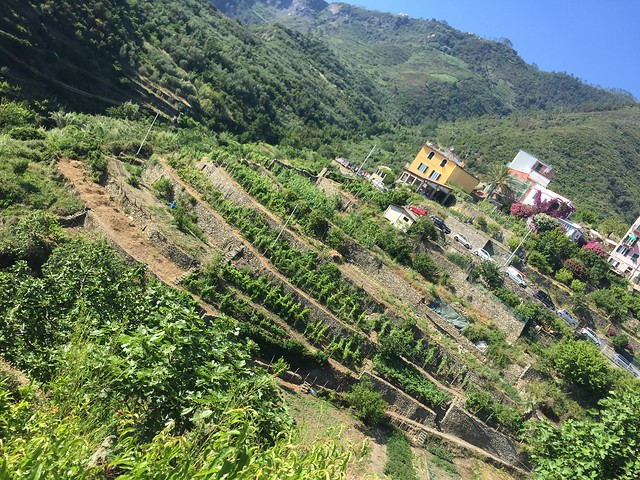
What to see in Corniglia:
- Church of St. Peter: A big beautiful church in gothic Ligurian style. It was built in 1334. While the chapel was built before 1000, unfortunately, the exact date is unknown.
- Chapel of Saint Catherine flagellants and the monument: The chapel is located in the central square of Corniglia; it was built in the XVIII century.
- On this square, there is a Monument to those who fell in Corniglia in 1926.
- Behind the chapel there is a very spacious terrace with a good view over the entire Riviera.
- Ruins of Genoese Fortress: In the past, a castle with huge tower stood here. Unfortunately, not much is left except some ruins near the cemetery.
- Guvano beach for nudists: A very beautiful beach between two villages: Corniglia and Vernazza.
- Sanctuary of Our Lady of Graces: Our Lady of the Graces Temple, though belonging to Corniglia, is in fact located in San Bernardino. It is a small hamlet near Vernazza. It is easier to reach the Sanctuary from Vernazza. This temple built in the 1800s is located on a mountain ridge not far from a small cluster of houses. It was built on the place of a former chapel of 1470.
- On the altar, there is a painting of Virgin Mary with Jesus of 1874.
- A magnificent view opens up from the church square to the village of Corniglia and the beach of Guvano.
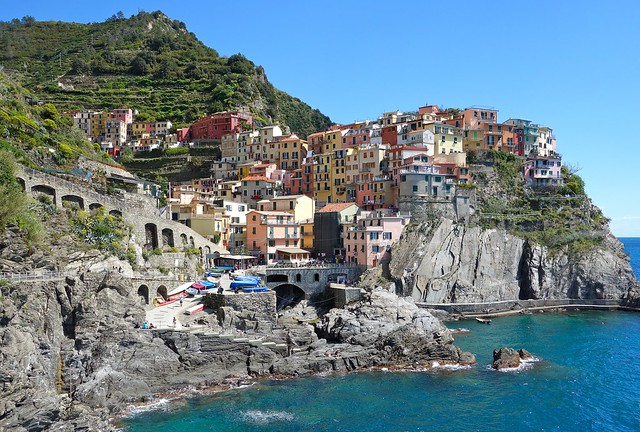
What to see in Manarola
- Presepe in Manarola (open in winter): Every country has its own Christmas traditions. In Italy, like in many other countries, it is an occasion to depict Christmas in different ways (sculptures, theatres). It is called the Nativity scene (crib, presepe). The biggest presepe in the world is erected in Manarola annually, and is opened on the 8th of December. The closing date may change, but usually it is the 31st of January or the beginning of February.
- Church of San Lorenzo: According to historical sources, it was built in 1338. Apparently, by Antelami masters. Architectural style: gothic, baroque.
- Fortress ruins: Remains of the bastion built in the XIII century can be seen in the buildings on the seafront. Its walls were used for construction of houses. As far as the castle built together with the bastion is concerned, nothing is left from it.
- Grope: A small hamlet near Manarola is famous for its wine. Here you can taste and buy real Cinque Terre wine. Groppo can be reached by bus or by foot.
- Sanctuary of Our Lady of the Health: It is one of the five famous sanctuaries of the Cinque Terre. It is located in Volastra. The Temple of Santa Maria della Salute has Roman origin and dates back to the X century. Virgin Mary printed in XVIII century can be found in the internal room under a cylindrical ceiling. It can be reached via the route "the Way to Volastra", described above.
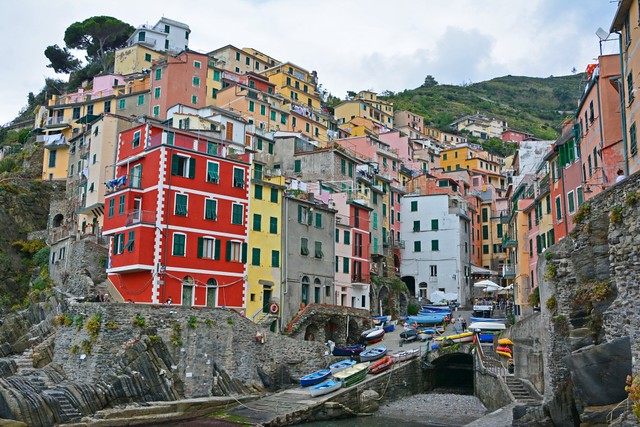
What to see in Riomaggiore
- Church of St. John the Baptist: The church is situated in the upper part of the historical centre of Riomaggiore. According to memorial plaque on the façade, Antelami masters at the wish of diocese bishop Luni Antonio Fieschi built the church in 1340. After a minor collapse, the church was completely renovated in 1870 - 1871.
- The art collection here includes a preserved painting “Preaching of John the Baptist” by artist Domenico Fiasella, a wooden crucifixion of Antonio Maria Maragliano, a marble cathedra of 1663, as well as other masterpieces of the XVII - XVIII centuries, and a mechanical organ of 1851.
- Cathedral of Santa Maria Assent: It is located in the very centre of the village on its main street - Via Cristoforo Colombo. It was built in the XV-XVI century.
- It contains a triptych of Jesus, Virgin Mary, St. John the Baptist and St. Dominic de Guzmán. There is a wooden statue of Madonna also.
- Castle of Riomaggiore: The Castle was intended as a protection against barbarian attacks. Its construction began in 1260 by Marquis Turcotti, and was completed during the times of the Genovese Republic. It is open to public.
- Behind it there is a terrace with benches, and it has a view on the Azure trail and seaside. It is a very romantic place.
- Sanctuary of Montenegro: First reference to the Temple of the Madonna di Montenero dates back to 1335, but according to a legend it was built in the VIII century. It was last renovated in 1847. Location of the temple is such that it gives you a bird’s eye view overlooking a huge stretch from the Cape of Mesco to the Tino Island. You can reach here via the route "the Riomaggiore Ring", described above or "The Way to Portovenere" passes through this sanctuary as well.
What to see in Portovenere:
- Town Gate and Tower
- Church of San Lorenzo
- Doria Castle
- The Mills
- Arpaia Cave (Byron)
- Church of San Pietro
- The "Palizzata"
- Tina Island
- Palmaria Island